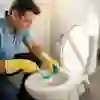Share:
Replacing a toilet seat is a straightforward DIY project that can refresh the look of your bathroom and improve comfort. Here, The Bathroom Showroom shows you the tools you’ll need along with an easy step-by-step guide to help you get the job done.

Tools You'll Need:
- New toilet seat (make sure it's the right size and shape for your toilet!)
- Tape measure
- Screwdriver (flathead or Phillips, depending on your existing bolts)
- Adjustable wrench or pliers
- Protective gloves
- Disinfectant cleaner and cloth
- Penetrating oil (like WD-40, optional, for stubborn bolts)
- Small hacksaw or bolt cutters (optional, for extremely stubborn bolts)

Step-by-Step Guide:
1. Measure Your Toilet Bowl (Before Buying a New Seat):
- Length: Measure from the centre of the two bolt holes at the back of the toilet to the front edge of the bowl. This determines if you need a round (typically 16.5-17 inches) or elongated (typically 18-18.5 inches) toilet seat.
- Width: Measure the widest point across the toilet bowl.
- Bolt Hole Spacing: Measure the distance between the two bolt holes. Most toilets have a standard spacing of about 5.5 inches (155mm in the UK).
- Compare these measurements to the dimensions on the new toilet seat packaging to ensure a proper fit. Also, consider the shape (round, elongated, or D-shaped).

2. Remove the Old Toilet Seat:
- Locate the Bolts: Most toilet seats are secured by two bolts at the back of the toilet, usually hidden under plastic caps.
- Remove Bolt Covers (if present): Use a flathead screwdriver to pry off any plastic caps covering the bolts carefully.
- Loosen the Nuts: Underneath the toilet bowl, locate the nuts that hold the bolts in place. Use your adjustable wrench or pliers to turn the nuts counterclockwise to loosen them.
- Lift Off the Old Seat: Once the nuts are loose or removed, lift the old toilet seat and its hinges away from the bowl.

3. Clean the Area:
- With the old seat removed, take this opportunity to thoroughly clean the rim of the toilet and the area around the bolt holes. This area can accumulate dirt, grime, and rust that is hard to reach when the seat is installed.
- Use a disinfectant cleaner and a cloth to ensure the surface is hygienic.
- Dry the area completely to prevent mould or moisture buildup under the new seat.

4. Install the New Toilet Seat:
- Position the New Seat: Place the new toilet seat on the toilet bowl, aligning the hinges with the bolt holes on the toilet. If your new seat has adjustable hinges, you can fine-tune the alignment now.
- Insert the Bolts: Drop the new bolts (usually provided with the new seat) through the hinges and into the mounting holes on the toilet bowl.
- Secure the Nuts: From underneath the toilet, screw the nuts onto the bolts. Start by tightening them by hand.
- Tighten with Tools: Use your screwdriver from the top to turn the bolts clockwise while holding the nuts steady underneath with your adjustable wrench or pliers.
- Add Caps (if applicable): If your new toilet seat comes with plastic caps to cover the bolts, snap them into place for a finished look.

5. Test and Adjust:
- Test the new seat by opening and closing the lid and the seat to ensure they move smoothly without obstruction.
- Sit on the seat to check for stability. It should not wobble or shift.
- If the seat is wobbly or not perfectly aligned, loosen the bolts slightly, adjust the seat, and then re-tighten.
FAQs When Installing a New Toilet Seat
How Do I Know Which Toilet Seat Will Fit My Toilet?
This is the most crucial step! Toilet seats are NOT universal. So, you’ll need to measure your toilet bowl carefully using the above guidance to ensure you get the correct size.
Toilets generally come in a few common shapes including round/oval which are more traditional and often found in older bathrooms, or elongated/D-shaped, which are more modern, often slightly longer and squarer at the front, as well as square which is less common, but used in some contemporary designs.
Are There Different Types of Toilet Seat Fixings?
Yes, there are two main types of toilet seat fixings, including:
- Bottom fixing: This is the most common, where bolts go through the toilet bowl and are tightened from underneath with nuts.
- Top fixing: Used when there's no access to the underside of the toilet bowl (e.g. some back-to-wall or wall-hung toilets). These systems are tightened from the top.
Always check the type of fixing your new seat uses and ensure it's compatible with your toilet.
What If the Bolts Are Stuck or Rusty?
- Use penetrating oil: If the bolts are rusty or stuck, apply a small amount of penetrating oil (like WD-40) and let it sit for 5-15 minutes. This can help loosen them.
- Extreme cases: If bolts are severely rusted or stuck, you might need to tap them with a hammer gently, or, as a last resort, use a mini hacksaw or bolt cutters to cut them off. Be very careful not to damage the porcelain of the toilet bowl.
- Important: Tighten the bolts until the seat is snug and doesn't wobble, but do not overtighten. Overtightening can crack the toilet bowl or the new seat.
Why Is My New Toilet Seat Wobbly?
- Loose bolts: The most common reason is that the bolts aren't tightened enough. Ensure they are secure.
- Uneven tightening: Try loosening and then re-tightening the bolts evenly.
- Wrong size/shape: If the seat is not the correct shape or size for your toilet bowl, it might not sit evenly, leading to wobbling. Double-check your measurements and the seat's compatibility.
- Washers: Some seats come with rubber or plastic washers. Ensure these are in place between the nuts and the toilet bowl for extra grip and stability.
What Are the Benefits of a “Soft-Close” Toilet Seat?
Soft-close toilet seats have hinges that allow the lid and seat to close slowly and quietly. This stops slamming, reduces noise, and can extend the life of the seat by preventing damage. They are also safer, especially in households with children.
By following these steps, you can successfully replace your toilet seat and enjoy a cleaner, more comfortable bathroom. For further guidance on tackling DIY bathroom tasks, check out our Help & Advice section.
With over 290 showrooms and several decades of experience, The Bathroom Showroom can help you create your dream bathroom with ease. Book an appointment today for further information on the fantastic services and huge range of bathroom products we offer.